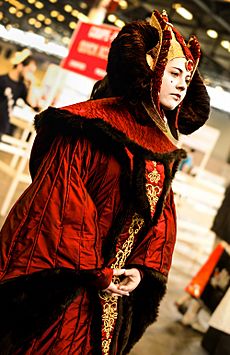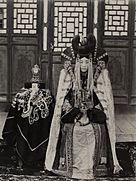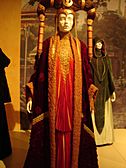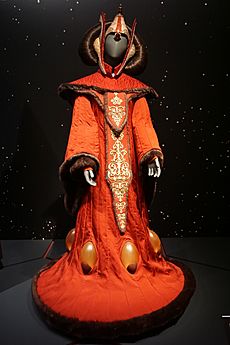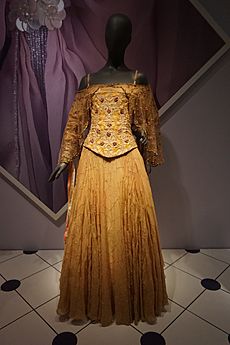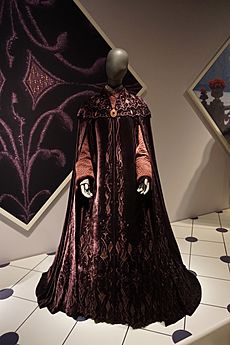Padmé Amidala facts for kids
Quick facts for kids Padmé Amidala |
|
|---|---|
| Star Wars character | |
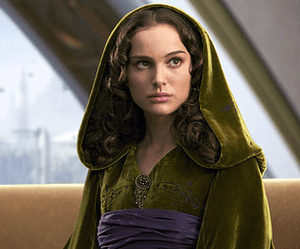
Natalie Portman as Padmé Amidala in Revenge of the Sith (2005)
|
|
| First appearance | The Phantom Menace (1999) |
| Created by | George Lucas |
| Portrayed by | Natalie Portman |
| Voiced by |
Other:
|
| Information | |
| Species | Human |
| Gender | Female |
| Occupation |
|
| Affiliation |
|
| Family |
|
| Spouse(s) | Anakin Skywalker |
| Children |
|
| Relatives | Canon:
Legends:
|
| Homeworld | Naboo |
Padmé Amidala (born Naberrie) is a brave and important character in the Star Wars movies. She appears in the prequel trilogy films, played by Natalie Portman. Padmé is first mentioned in Return of the Jedi. She is introduced in The Phantom Menace as the young Queen of Naboo.
After her time as queen, she becomes a senator. She works hard for peace in the Galactic Senate. Padmé secretly marries Anakin Skywalker, who is a Jedi Knight. She later dies while giving birth to their twins, Luke Skywalker and Leia Organa. Anakin's fear of losing Padmé helps push him towards the dark side of the Force. This is how he becomes the evil Darth Vader.
Many people liked Padmé's strong character and her political actions. Natalie Portman's acting helped her become famous around the world. Padmé is one of the main characters in the prequel trilogy. She also appears in other Star Wars stories, like The Clone Wars TV show.
Creating Padmé Amidala
When the Star Wars story was first being planned, Princess Leia was going to be Luke's cousin. Their mother was not a big part of the early ideas. Later, George Lucas, the creator of Star Wars, decided that Luke and Leia would be twins. He also decided that their mother would be an important character in the new movies he was writing.
Lucas wanted Padmé to be a strong and smart character. He wanted her to be like Carrie Fisher's character, Princess Leia. Natalie Portman, who played Padmé, felt that Leia's strength was passed down from Padmé. This helped her play Padmé as a fiery and intelligent woman.
Choosing the Actress and Her Look
George Lucas and his team looked at over 200 actresses for the role of Padmé Amidala. They chose 16-year-old Natalie Portman. Lucas was impressed by her acting in other movies. He said he wanted someone young and strong, like Leia. Natalie Portman fit these qualities perfectly.
Portman did not know much about Star Wars before she was cast. Her cousins were huge fans and were very excited for her. She was happy to play a young queen with so much power. She hoped Padmé would be a good role model for young women. Padmé was a strong leader who was also smart and took action.
Padmé's Amazing Costumes
Padmé Amidala wears many beautiful and detailed costumes. These were designed by Iain McCaig and Trisha Biggar. Many of her outfits were inspired by royal clothing from different cultures. For example, one of her Senate dresses was based on traditional Mongolian fashion. Her travel gown in Attack of the Clones was inspired by 17th-century Russian fashion.
The costumes in the prequel movies are much more fancy than those in the original movies. George Lucas explained that society in the prequels was more advanced. Padmé, as a queen and senator, would change her outfits often for different events. Originally, only three costumes were planned for Padmé in The Phantom Menace. But Lucas decided she should have a new costume almost every time she appeared.
The costumes also showed what was happening in the story. In Attack of the Clones, Padmé's outfits became more romantic. In Revenge of the Sith, her clothes were softer because she was pregnant. Some costumes were designed but never used in the movies. One beautiful "Peacock Gown" was only seen on the movie poster.
Trisha Biggar, the costume designer, won awards for her work on Padmé's costumes.
Padmé's Character and Personality
Padmé Amidala is shown as beautiful and graceful. She is very serious about her duties. She cares deeply about people who are struggling in the galaxy. She gave up much of her childhood to serve the public. Her sister, Sola, even told her she focused too much on her responsibilities.
Padmé often tries to solve problems through talking and diplomacy. She is usually a pacifist, meaning she prefers peace over fighting. However, she is also willing to use "aggressive negotiations" to protect democracy. She fights alongside the clone troopers when needed. She is a skilled fighter, using martial arts and blasters against battle droids. She can keep up with Jedi and is a great shot with a weapon.
As a leader, Padmé believes strongly in democracy and fair laws. She does not like corruption. She tells Anakin that true democracy is not just giving people what they want. It is about giving them what they need. She remains loyal to the Republic until it stops representing her beliefs.
Padmé can also be a bit mysterious. She often hides her true feelings from the public. She is very close to her handmaidens. Her secret marriage to Anakin and her private talks with other senators show her hidden side. She can be tough and commanding when needed, but also warm and loving as Padmé.
Padmé's Appearances in Films and Shows
Original Trilogy
Return of the Jedi
In Return of the Jedi, Luke Skywalker asks Princess Leia if she remembers their real mother. Leia says her mother was very beautiful, kind, and sad. She died when Leia was very young. Luke does not remember their mother at all. This movie hints at Padmé's story before the prequel films were made.
Prequel Trilogy
The Phantom Menace
Padmé Amidala first appears in The Phantom Menace. She is the newly elected 14-year-old Queen of Naboo. She wants to end the planet's takeover by the Trade Federation. She tries to negotiate with the Federation leader, Nute Gunray. But he tries to force her to sign a bad treaty.
With the help of Jedi Master Qui-Gon Jinn and his student Obi-Wan Kenobi, Padmé escapes Naboo. Their ship breaks down, forcing them to land on the desert planet Tatooine. There, Padmé, disguised as a handmaiden, meets a nine-year-old slave named Anakin Skywalker. She sees Anakin win a big podrace, which helps her mission and wins him his freedom. Padmé and Anakin become friends on their journey. He gives her a special hand-carved charm.
On Coruscant, Padmé talks to Naboo's Senator, Palpatine. He tells her to ask the Senate for help. Palpatine, who is secretly the evil Sith Lord Darth Sidious, tricks her. He convinces her to vote out the current leader, Supreme Chancellor Finis Valorum. This allows Palpatine to be elected in his place.
Padmé returns to Naboo to fight for her planet. She gets help from Jar Jar Binks and his Gungan people. Her handmaiden Sabé pretends to be her. While Sabé tries to make peace, Padmé reveals her true identity. The Gungans agree to help. They create a distraction for the droid armies. Padmé leads a small group into the palace and captures Gunray. This ends the blockade of Naboo. Everyone celebrates the new unity between Naboo and the Gungans.
Attack of the Clones
Padmé appears again in Attack of the Clones, set 10 years later. She is now a Senator for Naboo. She leads a group that does not want the Republic to create an army of clones. This is because a Separatist movement is growing. When she arrives on Coruscant, assassins try to kill her. Jedi Knight Obi-Wan Kenobi and Anakin Skywalker are assigned to protect her.
Palpatine sends Padmé to hide on Naboo. There, she and Anakin try to stay just friends, but they are clearly attracted to each other. In a scene not shown in the movie, Padmé introduces Anakin to her parents. She also tells him about her charity work helping refugees.
Anakin has a bad dream about his mother. Padmé goes with him to Tatooine to try and save his mother, Shmi, from Tusken Raiders. They are too late. Anakin returns with Shmi's body and tells Padmé he killed the entire Tusken tribe. Padmé is upset but comforts him.
They get a message from Obi-Wan on the planet Geonosis. Padmé and Anakin rush to help him. But they are captured and sentenced to death by the Separatist leader, Count Dooku. They tell each other they are in love. Just before they are killed, Jedi Masters Mace Windu and Yoda arrive with an army of Jedi and clone troopers. This starts the Clone Wars. Afterward, Padmé and Anakin secretly marry on Naboo. R2-D2 and C-3PO are their only witnesses.
Revenge of the Sith
Padmé's third film appearance is in Revenge of the Sith, three years into the Clone Wars. Anakin returns from rescuing Palpatine, and Padmé tells him she is pregnant. Padmé notices Anakin changing after he starts having visions of her dying during childbirth. Palpatine uses Anakin's fears to trick him. He says the dark side of the Force can save Padmé. This leads Anakin to become Palpatine's evil student, Darth Vader.
Padmé watches as Palpatine uses the war to gain almost total control of the government. In a scene not shown in the movie, Padmé is part of a group of senators who secretly oppose Palpatine. This group later forms the Rebel Alliance.
When Palpatine declares himself Emperor and turns the Republic into the Galactic Empire, Padmé says, "So this is how liberty dies—with thunderous applause." Obi-Wan tells Padmé that Anakin has joined the dark side and killed everyone in the Jedi Temple, even children.
Padmé cannot believe it. She travels to the volcanic planet Mustafar, where Vader has gone. Obi-Wan secretly hides on her ship. Padmé begs Vader to leave Palpatine. But Vader wants them to rule the galaxy together. Padmé is horrified and tries to convince him to leave the dark side. When Obi-Wan appears, Vader thinks Padmé betrayed him. He uses the Force to choke her until she passes out.
After Obi-Wan defeats Vader in a lightsaber fight, he takes Padmé to a secret base. She dies soon after giving birth to twins, Luke and Leia. Before she dies, Padmé tells Obi-Wan that she still believes there is "good" in Vader. Padmé's body is made to look like she was still pregnant. She has a grand funeral on Naboo. Yoda decides to separate her twins to hide them from the Empire. Leia is adopted by Bail Organa and his wife on Alderaan. Obi-Wan takes Luke to Tatooine, where he is raised by Vader's stepbrother Owen Lars and his wife Beru.
Live-action Series
Obi-Wan Kenobi
Padmé appears in a flashback at the start of Part I in the Obi-Wan Kenobi TV series.
Animated Series
The Clone Wars
Padmé Amidala (voiced by Catherine Taber) appears in the animated movie Star Wars: The Clone Wars. While Anakin and his student Ahsoka Tano search for Jabba the Hutt's son, Padmé meets Jabba's uncle, Ziro the Hutt. She tries to convince him to help the Jedi. Ziro tries to get rid of Padmé. She escapes and overhears him planning to kill Jabba's son and blame the Jedi. Padmé is discovered, but she tricks a droid into activating her communication device. She calls C-3PO, who brings guards to rescue her. Padmé then contacts Jabba and makes Ziro confess. She helps create an alliance between the Republic and the Hutts.
In the TV series The Clone Wars, Padmé mostly works in the Senate for peace. Some episodes show her fighting alongside Anakin, Ahsoka, and Jar Jar Binks. She appears in many episodes throughout the series. A group of episodes focuses on her meeting an old friend, Rush Clovis, which makes Anakin jealous.
Forces of Destiny (2017)
Padmé appears in the short animated series Star Wars: Forces of Destiny, again voiced by Catherine Taber.
Tales of the Jedi
Padmé's funeral is shown again in Tales of the Jedi in the episode "Resolve".
Books and Comics
Many Star Wars books and comics tell more about Padmé Amidala's life. The novel The Phantom Menace describes her as "something of an unknown" before the Trade Federation blockade. In Attack of the Clones, her sister Sola tells her to think about her own happiness. Revenge of the Sith explains Padmé's role in forming the Rebel Alliance.
Queen's Shadow, a novel by E. K. Johnston, focuses on Padmé and her handmaidens. It shows her helping free slaves on Tatooine after her reign as queen. She meets Rush Clovis and her relationship with Bail Organa and Palpatine is explored. A prequel, Queen's Peril, tells stories from before and during The Phantom Menace. A third novel, Queen's Hope, covers a secret mission she takes on during the Clone Wars.
Padmé also appears in flashbacks in the novel Thrawn: Alliances. In the comic series Princess Leia, Leia briefly sees a vision of Queen Amidala when she visits Naboo.
Video Games
Padmé also appears in many Star Wars video games. She is often a playable character, especially in games based on the Clone Wars stories.
Legends Stories
In April 2014, many Star Wars books and comics were called Star Wars Legends. These stories are no longer considered part of the main Star Wars timeline.
Clone Wars (2003)
Padmé Amidala appears in the animated micro-series Star Wars: Clone Wars. She stays on Coruscant and writes to Anakin while he fights in the Clone Wars. In one episode, she travels with Yoda and helps rescue Jedi Masters. In another, she is happy when Anakin becomes a Jedi Knight. She keeps his Padawan braid with the necklace he gave her.
Older Books and Comics
Older Star Wars books and comics tell about Padmé's life before the prequel films. In the comic "A Summer's Dream", Padmé is the Princess of Theed. A young man falls in love with her, but she chooses her duty to her people over her own feelings.
In the novel Cloak of Deception, Padmé is elected Queen of Naboo. She talks to Palpatine about the events leading to the Trade Federation blockade.
Other books, like Star Wars Episode I Journal: Amidala and The Queen's Amulet, focus on her early career and her close friendship with her handmaiden Sabé.
Padmé's role in the Delegation of 2000 is discussed in Labyrinth of Evil. This group of senators resisted Palpatine's growing power. Padmé believed Palpatine would give up his power when the crisis was over.
Padmé also appears in stories set after the original trilogy, as holograms and flashbacks. In The Joiner King, Luke Skywalker finds a hologram of Anakin telling Padmé about his vision of her death. This is the first time Luke sees his mother. Later, Luke and Leia hear their mother's name for the first time in another hologram. They also see her death and their own births.
Family Tree
| Skywalker family tree | ||||||||||||||||||||||||||||||||||||||||||||||||||||||||||||||||||||||||||||||||||||||||||||||||||||||||||||||||||||||||||||||||||||||||||||||||||||||||||||||||||||||||||||||||||||||||||||||||||||||||||||||||||||||||||||||||||||||||||||||||||||||||||||||||||||||||||||||||||||||||||||||||||||||||||||||||||||||||||||||||||||||||||||||||||||||||||||||||||||||||||||||||||||||||||||||||||||||||||||||||||||||||||||||||||||||||||||||||||||||||||||||||||||||||||||||||||||||||||||||||||||||||||||||||
|---|---|---|---|---|---|---|---|---|---|---|---|---|---|---|---|---|---|---|---|---|---|---|---|---|---|---|---|---|---|---|---|---|---|---|---|---|---|---|---|---|---|---|---|---|---|---|---|---|---|---|---|---|---|---|---|---|---|---|---|---|---|---|---|---|---|---|---|---|---|---|---|---|---|---|---|---|---|---|---|---|---|---|---|---|---|---|---|---|---|---|---|---|---|---|---|---|---|---|---|---|---|---|---|---|---|---|---|---|---|---|---|---|---|---|---|---|---|---|---|---|---|---|---|---|---|---|---|---|---|---|---|---|---|---|---|---|---|---|---|---|---|---|---|---|---|---|---|---|---|---|---|---|---|---|---|---|---|---|---|---|---|---|---|---|---|---|---|---|---|---|---|---|---|---|---|---|---|---|---|---|---|---|---|---|---|---|---|---|---|---|---|---|---|---|---|---|---|---|---|---|---|---|---|---|---|---|---|---|---|---|---|---|---|---|---|---|---|---|---|---|---|---|---|---|---|---|---|---|---|---|---|---|---|---|---|---|---|---|---|---|---|---|---|---|---|---|---|---|---|---|---|---|---|---|---|---|---|---|---|---|---|---|---|---|---|---|---|---|---|---|---|---|---|---|---|---|---|---|---|---|---|---|---|---|---|---|---|---|---|---|---|---|---|---|---|---|---|---|---|---|---|---|---|---|---|---|---|---|---|---|---|---|---|---|---|---|---|---|---|---|---|---|---|---|---|---|---|---|---|---|---|---|---|---|---|---|---|---|---|---|---|---|---|---|---|---|---|---|---|---|---|---|---|---|---|---|---|---|---|---|---|---|---|---|---|---|---|---|---|---|---|---|---|---|---|---|---|---|---|---|---|---|---|---|---|---|---|---|---|---|---|---|---|---|---|---|---|---|---|---|---|---|---|---|---|---|---|---|---|---|---|---|---|---|---|---|---|---|---|---|---|---|---|---|---|---|---|---|---|---|---|---|---|---|---|---|---|---|---|---|---|---|---|---|---|---|---|---|---|---|---|---|---|---|---|---|---|---|---|---|---|---|---|---|---|---|---|---|---|---|---|---|---|---|---|---|---|---|---|---|---|---|---|---|---|---|---|---|---|---|---|---|---|---|---|---|
|
||||||||||||||||||||||||||||||||||||||||||||||||||||||||||||||||||||||||||||||||||||||||||||||||||||||||||||||||||||||||||||||||||||||||||||||||||||||||||||||||||||||||||||||||||||||||||||||||||||||||||||||||||||||||||||||||||||||||||||||||||||||||||||||||||||||||||||||||||||||||||||||||||||||||||||||||||||||||||||||||||||||||||||||||||||||||||||||||||||||||||||||||||||||||||||||||||||||||||||||||||||||||||||||||||||||||||||||||||||||||||||||||||||||||||||||||||||||||||||||||||||||||||||||||
| Notes: | ||||||||||||||||||||||||||||||||||||||||||||||||||||||||||||||||||||||||||||||||||||||||||||||||||||||||||||||||||||||||||||||||||||||||||||||||||||||||||||||||||||||||||||||||||||||||||||||||||||||||||||||||||||||||||||||||||||||||||||||||||||||||||||||||||||||||||||||||||||||||||||||||||||||||||||||||||||||||||||||||||||||||||||||||||||||||||||||||||||||||||||||||||||||||||||||||||||||||||||||||||||||||||||||||||||||||||||||||||||||||||||||||||||||||||||||||||||||||||||||||||||||||||||||||
See also
 In Spanish: Padmé Amidala para niños
In Spanish: Padmé Amidala para niños


